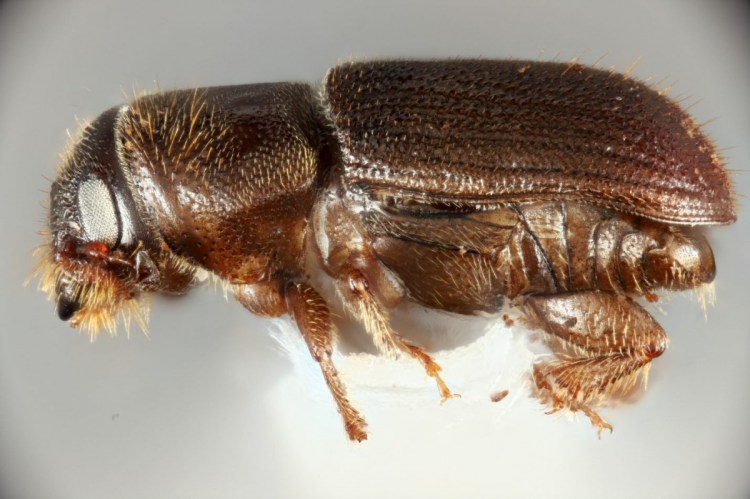When I learned that southern pine beetles, described in a recent University of New Hampshire press release as “one of the most damaging tree-dwelling insects in the Southeast,” have arrived in Maine, I worried that the Maine woods would be destroyed.
Maine is the Pine Tree State, after all.
Maine State Entomologist Allison Kanoti assured me that things aren’t that bad yet, but added that the insect is a cause for concern.
For starters, the southern pine beetle – which is about the size of a grain of rice – mostly attacks hard pine, specifically pitch pine. The dominant species in Maine is white pine, a soft pine, which the beetle, a native in the southeast United States, has so far left alone.
Still, “pitch pines are a scattered resource, and that is part of the reason this is concerning,” Kanoti said. “They are found in places with unique or unusual habitats.” Those places are mostly coastal, such as the barrens of York County.
The traps that caught the southern pine beetles in Waterboro and just over the state line in New Hampshire were placed by Caroline Kanaskie, a University of New Hampshire doctoral student in Natural Resources & Earth Systems Science. Other traps, set by Kanoti and the Maine Forest Service, have not captured any southern pine beetles. From this, the scientists conclude that while a few of the pests have reached the state, the population is small.
In 2015, Maine Forest Service staff helped monitor for the beetle in Long Island, New York, as part of a Northeast regional forestry team, Kanoti said. The following year, the same team began setting out traps for the insect in Maine. Clearly, the pest’s arrival was not a surprise to entomologists.
Kanoti directed me to a paper by Kevin Dodds of the U.S. Forest Service, whom she described as her “guru” on the southern pine beetle. In what sounds a little like the script of a horror film, Dodd wrote that when the temperature drops to 3.2 degrees, the southern pine beetle’s “body fluids crystallize, resulting in death after just a few minutes of exposure.”
That means that the sub-zero temperatures of a couple of weeks ago – temperatures that Maine had not had over the past three years – were not necessarily a bad thing. TV weather forecasters acted as though all of our lives were in immediate danger, but overall, the environment is better off.
The arrival of the beetle in Maine could be a harbinger of more problems to come from other damaging insect pests, Kanoti said. She noted that in the past few years, Maine has seen a lot more hemlock woolly adelgid. This aphid-like insect showed up in southern Maine more than a decade ago, and has since decimated hemlock populations in southern New England. One sign of its increase, Kanoti said, were black stains along Maine beaches last summer caused by the bodies of millions of dead hemlock woolly adelgids. The quarantine for the hemlocks was expanded in 2020 to include three southern counties and 29 additional towns. While hemlocks are still for sale in Maine – personally, I wouldn’t plant them in southern Maine – it is illegal to move any trees from the quarantine area.
Kanoti is also worried about the spotted lantern fly, a native of China. The pest’s eggs apparently arrived in Maine as part of a shipment of trees from out of state in 2020, but the state has done follow-up inspections and found no living lanternflies in Maine. I had thought that spotted lantern fly wouldn’t be a problem here because it requires tree of heaven (Ailanthus altissima) as a host plant and that plant, likewise native to China, does not live in Maine. Apparently, I was misinformed. If anyone does know of a tree-of-heaven plant in Maine, please contact the state, said Kanoti, who isn’t sure that Maine has none. She added that some evidence exists that the spotted lantern fly can feed on several other trees, including red maple and black walnut, both native to Maine.
Invasive, damaging plant pests are just one more way – along with droughts, forest fires, and lousy skiing and ice fishing – that climate change is going to, is already, damaging the world as we know it.
As responsible gardeners, we need to help slow down that damage by the way we manage our own gardens, scouring our property for pests and, if we think we’ve found evidence of them, immediately notifying state authorities.
Tom Atwell is a freelance writer gardening in Cape Elizabeth. He can be contacted at: tomatwell@me.com.
Send questions/comments to the editors.



Comments are no longer available on this story